Related Research Articles

Trajan was Roman emperor from 98 to 117. Officially declared by the Senate optimus princeps, Trajan is remembered as a successful soldier-emperor who presided over the second-greatest military expansion in Roman history, after Augustus, leading the empire to attain its maximum territorial extent by the time of his death. He is also known for his philanthropic rule, overseeing extensive public building programs and implementing social welfare policies, which earned him his enduring reputation as the second of the Five Good Emperors who presided over an era of peace within the Empire and prosperity in the Mediterranean world.

Vologases III was king of the Parthian Empire from 110 to 147. He was the son and successor of Pacorus II.

Osroes I was a Parthian contender, who ruled the western portion of the Parthian Empire from 109 to 129, with one-year interruption. For the whole of his reign he contended with the rival king Vologases III based in the eastern parts. In 116, Osroes I was briefly ousted from his throne at Ctesiphon during a invasion by Roman emperor Trajan, who installed his son Parthamaspates. After Trajans death the following year, Osroes I's rule was reinstated by the Parthian nobility. In 129, he was removed from power by Vologases III.

Characene, also known as Mesene (Μεσσήνη) or Meshan, was a kingdom founded by the Iranian Hyspaosines located at the head of the Persian Gulf. Its capital, Charax Spasinou, was an important port for trade between Mesopotamia and India, and also provided port facilities for the city of Susa further up the Karun River. The kingdom was frequently a vassal of the Parthian Empire. Characene was mainly populated by Arabs, who spoke Aramaic as their cultural language. All rulers of the principality had Iranian names. Members of the Arsacid dynasty also ruled the state.
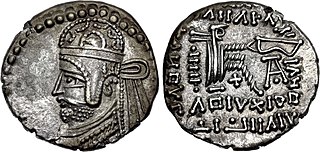
Sanatruces II of Parthia, was a pretender to the throne of the Parthian Empire during the disputed reign of his uncle Osroes I. He is only known from the writings of the Byzantine historian John Malalas (Chronographia), who is often not very reliable. The person of this ruler and the related events remain therefore enigmatic.
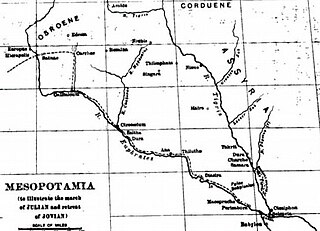
Assyria was reputedly a Roman province that lasted only two years.

The Arsacid dynasty or Arshakuni, ruled the Kingdom of Armenia from 12 to 428. The dynasty was a branch of the Arsacid dynasty of Parthia. Arsacid kings reigned intermittently throughout the chaotic years following the fall of the Artaxiad dynasty until 62 when Tiridates I secured Parthian Arsacid rule in Armenia. However, he did not succeed in establishing his line on the throne, and various Arsacid members of different lineages ruled until the accession of Vologases II, who succeeded in establishing his own line on the Armenian throne, which would rule the country until it was abolished by the Sasanian Empire in 428.
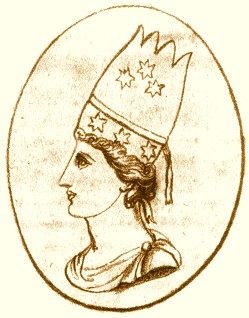
Erato also known as Queen Erato was a princess of the Kingdom of Armenia and member of the Artaxiad Dynasty. She served as Roman client queen of Armenia from 10 BC until 2 BC with her brother-husband King Tigranes IV. After living in political exile for a number of years, she co-ruled as Roman client queen of Armenia from 6 until 12 with the Herodian Prince Tigranes V, her distant paternal relative. As a queen of Armenia, she may be viewed as one of the last hereditary rulers of her nation.
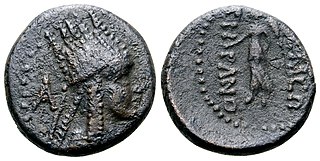
Tigranes III was a Prince of the Kingdom of Armenia and member of the Artaxiad Dynasty who served as a Roman Client King of Armenia.

The Parthian Empire, also known as the Arsacid Empire, was a major Iranian political and cultural power in ancient Iran from 247 BC to 224 AD. Its latter name comes from its founder, Arsaces I, who led the Parni tribe in conquering the region of Parthia in Iran's northeast, then a satrapy (province) under Andragoras, in rebellion against the Seleucid Empire. Mithridates I (r. c. 171–132 BC) greatly expanded the empire by seizing Media and Mesopotamia from the Seleucids. At its height, the Parthian Empire stretched from the northern reaches of the Euphrates, in what is now central-eastern Turkey, to present-day Afghanistan and western Pakistan. The empire, located on the Silk Road trade route between the Roman Empire in the Mediterranean Basin and the Han dynasty of China, became a center of trade and commerce.
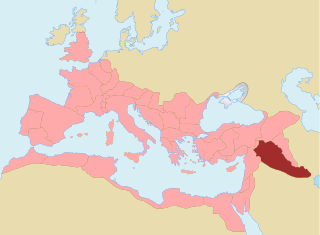
Mesopotamia was the name of two distinct Roman provinces, the one a short-lived creation of the Roman Emperor Trajan in 116–117 and the other established by Emperor Septimius Severus in ca. 198, which ranged between the Roman and the Sassanid empires, until the Muslim conquests of the 7th century.
The Roman–Parthian Wars were a series of conflicts between the Parthian Empire and the Roman Republic and Roman Empire. It was the first series of conflicts in what would be 682 years of Roman–Persian Wars.

This article discusses the Roman influence in Caucasian Albania.
Romans in Persia is related to the brief invasion and occupation of western and central areas of Parthia by the Romans during their empire. Emperor Trajan was even temporarily able to nominate a king of western parts of Parthia, Parthamaspates, as ruler of a Roman "client state" in Parthia.

King Manisarus was a 2nd-century king of the Corduene, which was a small vassal state during the Roman Empire. He has also been described as "perhaps prince of the Praetavi, whose capital was Singara". During his rule he took control over parts of Armenia and Mesopotamia, and Osroes I of Parthia declared war on him. Manisarus petitioned the Roman Emperor Trajan, offering him territory taken from supporters of Osroes in return for his support, an offer which was evidently accepted. Trajan also acquired the kingdom of Corduene at this time but only temporarily.
Parthamasiris, also known as Partamasir or Parthomasiris was a Parthian Prince who served as a Roman Client King of Armenia.

Attambelos II was a king of Characene, a Parthian vassal state and important trading port on the Persian Gulf. His rule was from 17/16 to 9/8BC.

Attambelos V of Characene was a ruler of the state of Characene who ruled from 64/65–73/74 but who is known only from the coins he minted.
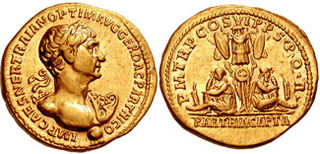
Trajan's Parthian campaign, also known as Trajan's Parthian War, was engaged by Roman Emperor Trajan in 115 against the Parthian Empire in Mesopotamia. The war was initially successful for the Romans, but a series of setbacks, including wide-scale rebellions in the Eastern Mediterranean and North Africa and Trajan's death in 117, ended in a Roman withdrawal.
Persian war of succession may refer to:
References
- ↑ Mommsen, The provinces of the Roman Empire: from Caesar to Domitian, p.66
- ↑ Potts, Araby the Blest: Studies in Arabian Archaeology, p.150
- ↑ Potts, Araby the Blest: Studies in Arabian Archaeology, p.151
- ↑ Farrokh, Shadows in the Desert: Ancient Persia at War, p.158
- ↑ Yarshater, The Cambridge History of Iran, Volume 3, p.87
- ↑ Bunson, A Dictionary of the Roman Empire, p.303
- ↑ Mommsen, The provinces of the Roman Empire: from Caesar to Domitian, p.66
- ↑ Potts, Araby the Blest: Studies in Arabian Archaeology, p.p.150&151
- ↑ Yarshater, The Cambridge History of Iran, Volume 3, p.87